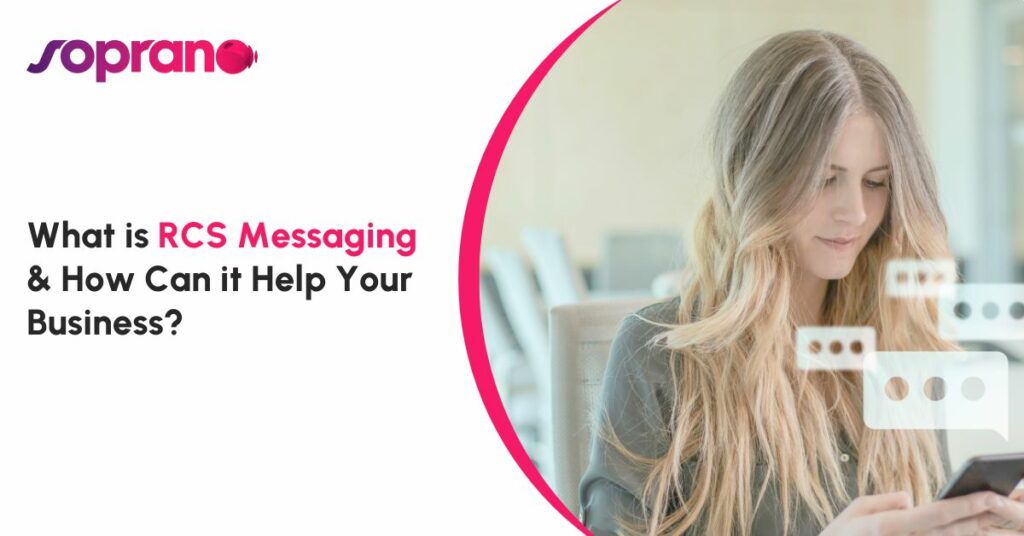
RCS messaging has been making headlines in recent months on the back of Apple ending years of speculation and announcing they’d be adopting the messaging standard in 2024.
But what actually is RCS messaging, why is it important, and what are some of the benefits it can bring when implemented effectively?
In this blog post we’re going to dive into all things RCS messaging so you can make an informed decision on whether it’s the right messaging channel you should use to engage with your customers.
What is RCS Messaging?
Also known as RCS Chat, RCS (Rich Communication Services) messaging is essentially a communication protocol that enables the sending of feature-rich messages.
Think of things like read receipts, seeing when someone else is typing, and the ability to send video or audio messages — these are all examples of RCS messaging in action.
It was built in 2008 by the Global System for Mobile Association to provide a slicker alternative to SMS that could compete with the incoming wave of smartphone messaging apps that today are household names like WhatsApp and Facebook Messenger.
But it wasn’t until almost 10 years after it was introduced that RCS messaging really started to pick up.
That’s when Google acquired an RCS platform called Jibe Mobile as part of a wider strategy to bring RCS chat to its Android offering, hence why RCS is often associated with Android devices.
Fast forward to today and there are more than 1 billion users across the world using RCS messaging — many of which are businesses using the messaging protocol to communicate with their customers, but that number could soon be set to grow, by a lot.

Why is Apple’s Recent RCS Announcement Important?
When you consider the point mentioned earlier that RCS messaging has long been associated with Android, it becomes clear why Apple’s recent RCS announcement is a pretty big deal.
By adopting the RCS messaging standard, Apple is taking a significant step towards improving cross-platform messaging interoperability and widening the potential reach of RCS chat – huge for businesses that want to use the channel to better engage with their customers.
Put simply, the more people you’re able to send feature-rich messages to, the more likely it is that your conversion rate will rise — but as you’ll soon discover, that’s just one of the benefits of RCS messaging for businesses…
What Are the Benefits of RCS Messaging for Businesses?
Now we’ve established what RCS messaging is and why it’s been in the news lately, let’s unravel the key benefits that make it a game-changer for enterprise businesses keen to improve their customer interactions.
Better Customer Engagement
The ability to send dynamic, feature-rich messages makes for a more seamless, immersive and enjoyable customer experience, and the numbers back it up.
Google data shows that 74% of people are more likely to engage with a brand through RCS and are 35x more likely to read an RCS message than an email that lands in their inbox.
Higher Conversion Rates
The knock-on effect of better customer engagement is higher conversion rates.
The more likely your customers are to open and engage with the messages you send them, the more likely they are to act, whether that’s giving feedback, confirming details, or making a purchase.
Interactive Conversations
By promoting two-way communication, RCS allows you to understand your customer better, the way they talk and the questions they have.
This data is invaluable and can help inform wider business decisions that provide a better user experience away from just messaging.
Improved Security
Thanks to its end-to-end encryption, RCS messaging is more secure when compared to SMS.
Additional features like verified sender information and digital signatures also make it more difficult for scammers to target and help prevent smishing attacks.
Increased Brand Visibility
By enabling you to send messages that feature your business’s colours, logos and images, RCS helps increase your brand visibility as well as building trust amongst your customers too.
Seeing your branding in a message helps customers easily identify your business and increases the likelihood that they’ll take the desired action you’re looking for.
Deeper Analytics and Insights
A secondary benefit of all the additional messaging features RCS boasts is the more detailed insights you can learn.
Aside from standard open and click-through rates, RCS messaging lets you see if you’re receiving common replies or if users are continually dropping off at a certain point in your customer journey.

Examples of RCS Chat in the Wild
Next up it’s time to look at some real-life examples of RCS messaging to give you a better understanding of how you can implement it into your communication strategy.

In this first example, you can see how Subway are using RCS to reach out to their customer base and promote a promotional offer.
Notice how the message is branded and features the Subway logo as well as a link to ‘View My Offer Now,’ all these snippets help create a more personalised user experience and increase the likelihood of generating a conversion.

Look at how Walgreens uses RCS messaging to give potential customers with an easier way to find their nearest store by adding a clickable navigation button.
Again, this example shows how RCS chats can make life easier for the end user without the need for a human customer service agent to step in.

Virgin Trains is using RCS messaging to help make life easier for their passengers.
By understanding that people may be travelling to a new area and in need of a helping hand, they’ve added clickable direction links to their e-ticket messages – also note how customers can reply to these messages too.
What Is the Difference Between RCS and SMS?
When talking about RCS messaging, there’s always a common question that comes up: what’s the difference between RCS and SMS?
In short, SMS messaging offers a cheaper, simpler, more basic way to communicate with your customers, which is to be expected when you consider it was invented back in the 90s!
RCS on the other hand is a more sophisticated messaging protocol that enables you to provide a richer, more engaging, and more visually dynamic communication experience.

With that said, both provide great ways to communicate with your customers. What’s important to understand is that the way you want to interact with your customers and the information you want to gain from that interaction will educate whether RCS or SMS messaging is the right fit for your business.
RCS Vs SMS: All You Need To Know About Both Messaging Channels
What you’ll often find is that an integrated messaging solution that combines both SMS and RCS will be the best way to connect with your customers, this is where we can help you.
Soprano’s RCS Messaging Solution
Our omnichannel platform, Soprano Connect, has been specifically designed to help large enterprise businesses and government organisations communicate with their customers better.
Whether you have requirements to send basic SMS alerts and reminders to thousands of recipients, or more personalised RCS messages to a segmented list of customers, we can work closely with you to create a bespoke solution that fits your needs.
Get in touch with one of our solution specialists today and tell us how you’d like to implement RCS or SMS messaging into your communication strategy.


